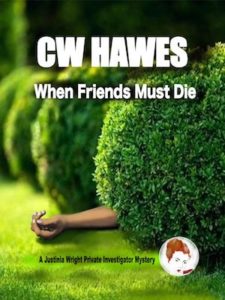The latest Justinia Wright Private Investigator Mystery, When Friends Must Die, is now available. There are a total of seven books in the series (if we count Book 0, which Amazon doesn’t).
To be honest, of all the characters I’ve created Justinia Wright is my favorite. She was my first child, so to speak, and I know her so well it’s as though she’s a real person.
But in this age of thrillers and books whose pages turn themselves, Tina and her brother, Harry, have been a hard sell.
Rex Stout’s Nero Wolfe books are the ideal detective reads, in my opinion. They have a bit of Sherlock Holmes and a touch of noir, a smidgeon of philosophy, and a lot of wisecracking banter. I will take Nero Wolfe any day over any other fictional detective out there — including the Great Detective himself.
However, the Nero Wolfe novels aren’t thrillers by today’s standards, and while excellent reads I do have to turn the pages myself. And therein lies the rub.
If the mystery writers of the Golden Age were plunked down into today’s publishing world as newbies, I doubt they’d make it. Why? Because at times their books are ponderously slow by today’s standards. The riveting action usually doesn’t appear until the last quarter to third of the book. The front part is all clue gathering and sub-plot and character development. This makes for a slower read, but one in which the plot is more nuanced and the characters are more richly drawn.
Just think, in today’s market the likes of Agatha Christie, Patricia Wentworth, Ngaio Marsh, and Rex Stout might never have seen a book contract from a publisher. And if they’d gone indie, they might have sold books, but I doubt their names would be household words.
In his day, the very prolific Edgar Wallace was selling mysteries like the proverbial hotcakes. Today, virtually none of his books are in print. He often has plenty of action, but his books are in no way, shape, or form thrillers.
Even Erle Stanley Gardner, creator of Perry Mason, is edging towards oblivion as the generation that grew up reading and watching Perry Mason dies off. Why? Because for all the action, they aren’t thrillers.
Which introduces an interesting dynamic in the mystery vs thriller debate. The mystery reader tends to be older. The thriller reader, younger.
Today’s reader, especially readers of indie books prefer action — just like the pulp magazine readers of yore.
But there are writers of mysteries, traditional mysteries, who are managing to sell books. PF Ford, JA Mensies, and Renee Pawlish to name three.
There are, however, more writers of good mysteries who deserve a much bigger audience. Richard Schwindt and his Death in Sioux Lookout trilogy. Joe Congel with his Tony Razzolito, PI series. JP Choquette and her Tayt Waters mysteries. Just to name a few.
But why read traditional-style mysteries instead of thrillers? Primarily because I think they are overall more entertaining and engaging reads. Mysteries tend to be multi-dimensional, whereas thrillers, at least the ones I’ve read, are pretty much one dimensional. Kind of like superhero comic books. There’s a lot of unrelenting action and that’s about it.
Of course superheroes are all the rage, so maybe that explains the appeal of thrillers.
A good mystery is plot-driven, has multi-faceted characters, an engaging storyline, and a certain literary finesse. A good mystery engages one on a more intellectual level. But a good mystery isn’t all in the mind, because there will be plenty of action scenes to get the heart pumping.
Which is my point: a good mystery is a wholistic read. It appeals to the reader on many different levels.
Give PF Ford, JA Menzies, and Renee Pawlish a try. Give Richard Schwindt, Joe Congel, JP Choquette, and even my own Justinia Wright a try. You just might discover a whole new world opening up before you.
Comments are always welcome! And until next time, happy reading!
Share This!


Interesting, Christopher. Though Agatha Christie remains very popular, not least on the silver screen. And modern readers seem patient enough with books like ’50 Shades of Grey’ which has 100 pages before the couple actually start doing what we all bought the damn book for in the first place! (Or so I’m told. I didn’t actually read it myself, of course. That’s my story and I’m sticking to it…)
And then there’s ‘Twilight’s’ 40-page conversation in a car! Modern literature is wonderful…
If I may be so bold, John, I think TV and the silver screen have saved Ms Christie. Plus her reputation. Reputation does a lot. I think reputation has saved Milton, for example. David Suchet’s incomparable portrayal of Poirot has also done much to save Ms Christie. I’ve read a number of Miss Marple novels and stories. I find them dated. I’ve read the short stories the Poirot TV series was largely based on and find them dated as well. TV and movies have made those dated tales come alive, in my opinion.
As for 50 Shades and Twilight, I think romance operates on its own set of rules. Readers, anticipating the scenes they bought the book for, will endure 100 pages of exposition to get there. Anticipation drives them on. The same with the 40 page car conversation. The reader knows there are good things to come and will endure it. Or maybe just skip over it. 😉
The wonderful thing about books is that there is literally something for everyone — and that’s a good thing!
Good day to you, Christopher, and I hope this finds you well. I couldn’t resist adding my two cents, which is the risk you run when you post in a public forum!
First, on Justina Wright: I like the old mysteries, my personal favorite being Sherlock, but here’s my experience with Justina. I was looking at all of your work on one page (don’t remember where), and through my own misreading, ordered Festival of Death thinking it was one of your steampunk novels. My disappointment was huge when I realized what I’d bought, but then I thought, “What the hell, I’ve paid for this, I might as well see what it’s about.” I sat down to read the introductory paragraphs, and didn’t stop turning pages until I came to The End. It’s a hell of a fine book and series, and well worth the reading!
As to your general premise here, I think people want the old stuff and just don’t realize it. I grew up reading boys-own adventure stories from the 1920s that I acquired at thrift shops and used-book stores, and was really sad when they disappeared from the modern literary field. I decided that if no one else was going to write them, I would do it myself, and thus Beyond the Rails was born, very old-style stories set in unexplored lands. But here’s the thing: I’ve never achieved that “critical mass” of readers we all dream of, but everyone who has read it loves it, unless a bunch of strangers are all lying to stroke my ego. I’ve offered stories that might have been written in 1922, and readers have embraced them like they’ve never seen them before. Hmmm… Maybe we should concentrate on getting that word out; could pay huge dividends down the road!
Greetings to you, Jack! Thanks for stopping by. I’m well, as I hope you are. And thank you for the shout out on Justinia!
I’m inclined to agree with you. I think much of the action on every page, pages turn by themselves mentality comes from traditional publishing. They’re trying to save market share. Although the action on every page approach was very much in order during the pulp era. Which was opposite of traditional publishing’s more literary approach!
Readers want an interesting and exciting story. They want characters they can relate to. That’s the bottom line. Your own Beyond the Rails and The Stone Seekers provide that. But there’s no action for the sake of action. You have story. You have characters who drive the stories.
You mention Sherlock Holmes. There is no unrelenting action in the Sherlock Holmes stories. What you have is an interesting adventure with interesting characters and enough action to get the heart pumping.
The problem I think for writers in general and Indies in particular is the sheer volume of books being published. The last number I read was 3,000 books per day appear on Amazon, which has millions of books already available.
To gain “critical mass” requires a huge time investment and perhaps money investment to gain notice. And most writers, including myself, don’t want to spend the time and probably don’t have the money. So, for myself, resigned to the fact I will have to at least spend time, I’ve chosen to pursue inexpensive ways to promote my work.
I’ve gained a few fans, and I mean few, in the 4 years I’ve been self-publishing. For me, those few fans drive me on to keep writing and find more fans. But it is very difficult work that I don’t particularly like. Wish I could hire a PA to do it all for me. 🙂
So you may be on to something here. But how do we package the message that we have what the readers really want to read? You’ve given me something to focus my marketing efforts on. 🙂